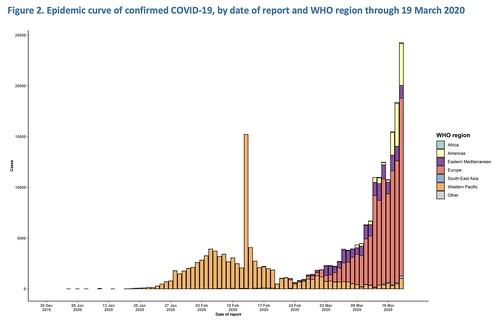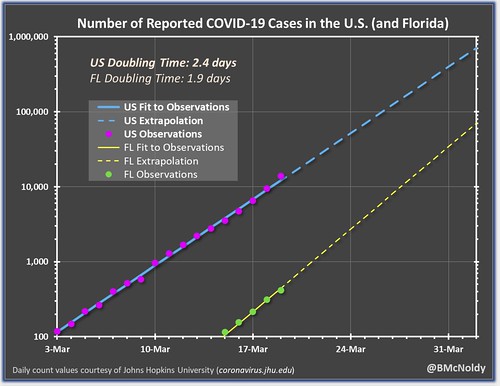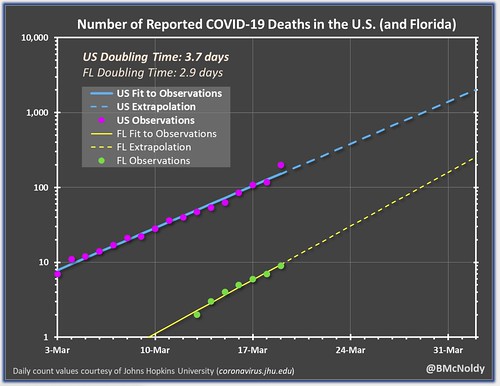As always, a reminder that I am not a medical doctor. I know a few, and they are all awesome! But I am not one. Nor am I a healthcare professional of any kind. These updates are my way of helping everyone sift through the riff-raff. My goal with these posts is to pass along relevant information from the medical community – direct from the source – with some translation into regular English.
The Numbers
Here is a look at the numbers today vs. where they were just one week ago.
Total cases: 15,219 (1,215 on March 13th)
— Travel-related: 337 (125 on March 13th)
— Close contact: 321 (102 on March 13th)
— Under investigation: 14,561 (988 on March 13th)
Total deaths: 201 (36 on March 13th)
States reporting cases: 50 states, District of Columbia, Puerto Rico, Guam, and US Virgin Islands (42 states and the District of Columbia on March 13th)
(Numbers pulled from other reliable resources) Total cases reported by other medical sites:
Johns Hopkins: 19,624 (1,268 on March 13th)
Deaths:260 (didn’t take this number on March 13th)
Recovered: 147
Here is a look at the chart from the World Health Organization highlighting the number of cases globally:
Brian McNoldy, Senior Research Associate at Univ. of Miami’s Rosenstiel School, put this next chart together. As it notes, it is pulling numbers from the Johns Hopkins totals. It shows the double-time of cases as about two-and-a-half days:
He also plots the number of deaths, too. And sadly, that too, has a doubling time.
A big thanks to Brian and all of the data scientists out there making all of this information more digestible.
Might be tough to tell if your child is infected
In a new study from a children’s hospital in China, only 40-percent of kids who had COVID-19 registered a fever. Nearly 60-percent had a fever less than 100-degrees. And said fever only lasted three days.
Other symptoms were cough (only about 50-percent had one), throat inflammation (only about 45-percent had this), and an increased heart rate (about 40 percent had this).
About 15-percent of kids showed zero symptoms. That means some children can have it, pass it along, and get better, without even knowing they are/were ever sick.
COVID-19 is airborne, but not like some are reporting
I have some good news to pass along. After doing some more digging and poking around, I found a great little thread on twitter from a Stem Cell Biologist. In it, she explains the distinction between “droplets” and “aerosols” in that study:
In a nutshell: COVID-19 patients likely cough/sneeze DROPLETS, which are larger than aerosols and all fall to the floor within 1-2m, give or take.
AEROSOLS are smaller so can last in air for longer, but are very likely only produced in hospitals after certain medical procedures
— 🔬Samantha Yammine, PhD (aka Science Sam) (@heysciencesam) March 20, 2020
Previously, I wrote:
According to Johns Hopkins the virus may spread through airborne transmission, when tiny droplets remain in the air even after the person with the virus leaves the area. This is why it is important to avoid people who are coughing. Even if you are walking 10ft behind them, you may still be at risk for inhaling one of the microscopic airborne droplets.
Those droplets are usually – according to the National Center for Biotechnology Information – under 5 micrometers in size. The Coronavirus is about 120 nanometers in size.
So for easy math, let’s say someone sneezes and leves airborne droplets that at 4 micrometers in size. Those tiny droplets float around – and there could be hundreds – carrying with them about 30 viruses each. And those viruses can start to multiple the second they hit a surface.
This still holds true. Don’t follow too close behind someone.
But to say that the virus can hang in the air for hours, in a non-medical setting, is unlikely.
From A few research universities
Northwestern Doctors
University of Pittsburgh
There was a report today from a local television station that the University Center for Vaccine Research had attached part of the virus to a measles vaccine. I’m efforting some more information on this as it could prove to be useful down the line.
That said, keep in mind that a vaccine is still 18 months – at the earliest – away.
Harvard Medical
Dr. Todd Ellerin, an infectious diseases physician at South Shore Health in Weymouth Massachusetts and an instructor in medicine at Harvard Medical School, offers insight—and practical information– from the front lines in the battle to stem COVID-19.
Mayo Clinic
Kristin Lothman, a mind-body counselor with Mayo Clinic’s Department of Integrative Medicine and Health, offers some insight into the stress of dealing with COVID-19.
Lothman points out on the Mayo Clinic website that “guided meditation” can be helpful, noting that breathing exercises are also valuable, especially for younger children.
New clinical trial begins on treatment
The study, titled, “Chloroquine Prevention of Coronavirus Disease (COVID-19) in the Healthcare Setting” is set to begin in May. Because trials are just starting, I couldn’t find data on any treatments that have already used this drug. The researchers behind the study note:
The study is a double-blind, randomised, placebo-controlled trial that will be conducted in health care settings. After obtaining fully informed consent, the investigator will recruit healthcare workers, or other individuals at significant risk who can be followed reliably for 5 months. 10,000 participants will be recruited and the investigator predict an average of 200 participants per site in 50 sites.
The participant will be randomised to receive either chloroquine or placebo (1:1 randomisation). A loading dose of 10mg base/kg, followed by 150 mg daily (250mg chloroquine phosphate salt) which will be taken for 3 months or until they are diagnosed with COVID-19. Subsequent episodes of symptomatic respiratory illness, including symptomatic COVID-19, clinical outcomes, and asymptomatic infection with the virus causing COVID-19 will be recorded during the follow-up period.
But, don’t look for Chloroquine to be widely administered to patients any time soon.
The clinical trial ends in May. Of 2022.
Until then, it may only be administered to patients on a patient-to-patient basis, based on the doctors decision.
From the FDA
I’ve seen a flurry of companies – falsely – claiming they have a “Home test kit” for COVID-19.
There is no such thing. Well, I shouldn’t say that, because obviously, there is such a thing. But there is no such legitimate thing at this time.
The U.S. Food and Drug Administration is actively and aggressively monitoring the market for any firms marketing products with fraudulent coronavirus (COVID-19) diagnostic, prevention and treatment claims as part of our ongoing efforts to protect public health during this pandemic. As a result of these activities, the agency is beginning to see unauthorized fraudulent test kits that are being marketed to test for COVID-19 in the home.
We want to alert the American public that, at this time, the FDA has not authorized any test that is available to purchase for testing yourself at home for COVID-19. The FDA sees the public health value in expanding the availability of COVID-19 testing through safe and accurate tests that may include home collection, and we are actively working with test developers in this space.
Fraudulent health claims, tests, and products can pose serious health risks. They may keep some patients from seeking care or delay necessary medical treatment. The FDA reminds consumers to follow the U.S. Centers for Disease Control and Prevention’s guidelines and speak to your medical provider if you have symptoms of COVID-19. Your medical provider will advise you about whether you should get tested and the process for being tested with an appropriate test.
The FDA was also mentioned by the President for the testing of Cholorquine. I don’t often include other “press” in these, but the below video features a few comments from Dr. Anthony Fauci, the Director of the National Institute of Allergy and Infectious Diseases and as a member of the White House Coronavirus Task Force, in the beginning trying to explain why the expectations and hopes of this drug need to be held in check for the time being
Fauci notes that: Clinical trials are going to be the things that tell the world, for certain, if this is – in fact – going to work.
Coronavirus & Pets
There have been a handful of reports from China that dogs became infected with Coronavirus. This seems unlikely, though not impossible. The World Health Organization recently found that dogs cannot transmit the virus. However, the medical research community thinks – like SARS – it started in bats and, perhaps, civets. But there was a paper that noted that other animals could be transmitters – but only if infected by another animal.
Yushun Wan, Jian Shang, Rachel Graham, Ralph S. Baric, and Fang Li wrote in the Journal of Virology:
Pigs, ferrets, cats and non-human primates contain largely favorable 2019-nCoV-contacting residues in their ACE2, and hence may serve as animal models or intermediate hosts for 2019-nCoV
But until an animal has been in contact with another animal with the Coronavirus, it is not going to carry the virus.
There is still research to be done. For all pets. But for now, I think it is still safe to trust the WHO.
Speaking of the WHO…
You can now get updates straight from the WHO.
To increase access to reliable information, WHO has partnered with WhatsApp and Facebook to launch a WHO Health Alert messaging service. This service will provide the latest news and information on COVID-19, including details on symptoms and how people can protect themselves. The Health Alert service is now available in English and will be introduced in other languages next week. To access it, send the word “hi” to the following number on WhatsApp: +41 798 931 892.
Charges may apply? I’m not certain. I couldn’t find any information on that.
The WHO also noted that the first vaccine trials began.
The first vaccine trial has begun just 60 days after the genetic sequence of the virus was shared by China. This is an incredible achievement. To ensure clear evidence of which treatments are most effective, WHO and its partners are organizing a large international study, called the Solidarity Trial, in many countries to compare different treatments.





